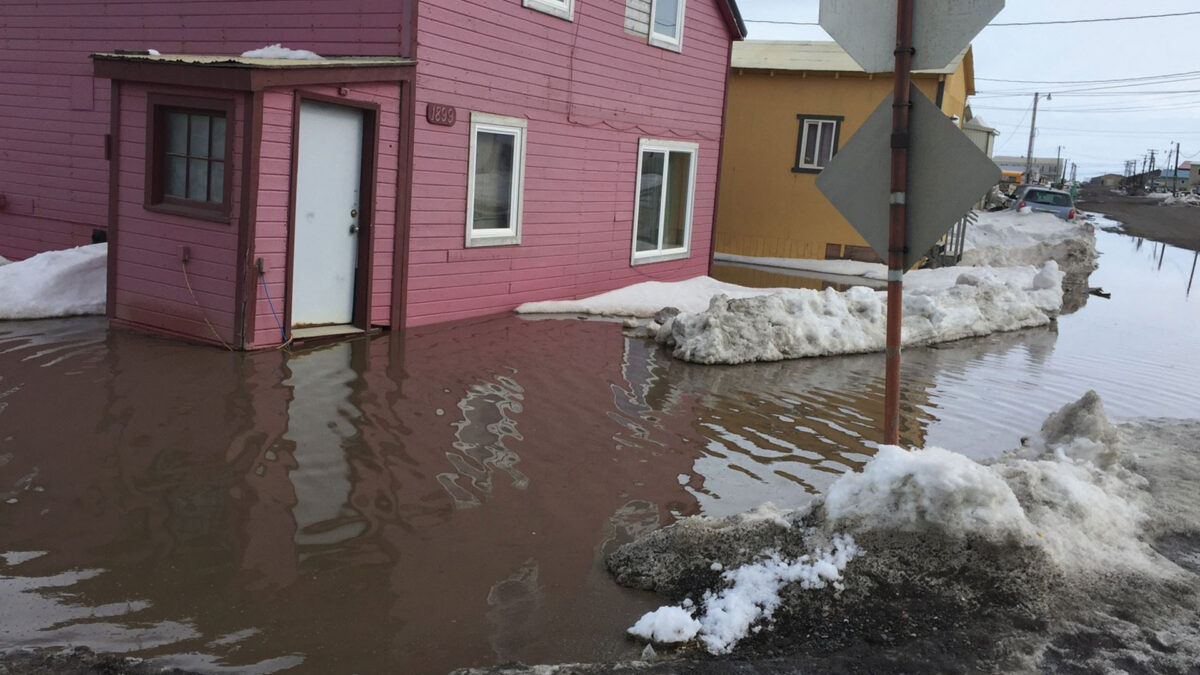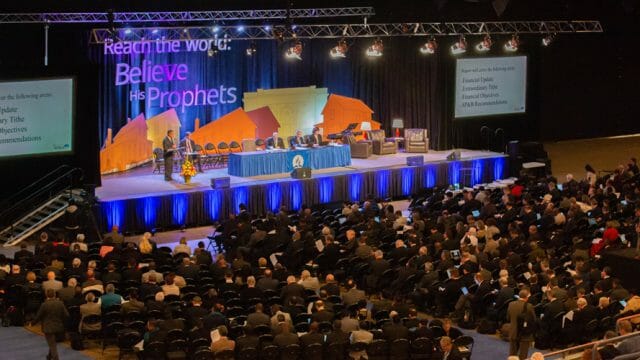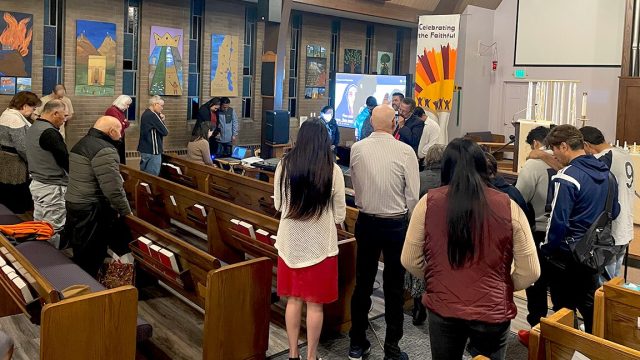“It’s our church,” they said, “but it’s a big pink church that’s tilting and sinking.”

The church was pink, bright pink, planted in permanently frozen ground on a street corner in Utqiagvik (Barrow), Alaska. “On the edge of the freezing sea and close enough to the North Pole to confuse your compass.”
Unfortunately, the “permafrost” beneath the church was melting more rapidly than ever before, and the pink Seventh-day Adventist church was sinking into the ground. Someone had to do something!
Jim John, pastor of the Anchorage Northside church, 725 air miles southwest, heard God call his name.
“I had a large map of Alaska on my office wall, a map with a few spreadout dots showing our churches and schools, and then this enormous empty space. There are more than 200 villages in Alaska with no Adventist presence. There are no roads, so the only way to reach those places is to fly, or to send ministry programs on radio.”
Radio is consistent and available to everyone, so the Alaska Conference has chosen to produce programs in local languages. Getting a low-power station “on the air” in each remote village requires a radio tower, specialized equipment, and a ton of permits. A perfect challenge for ministry-minded Adventists.
The Northside church joined the conference in raising radio towers in several remote villages and then chose to focus on Utqiagvik, home to the northernmost Seventh-day Adventist church in North America (and possibly beyond).
* * *
In 2020, when Pastor Jim and a small team arrived in Utqiagvik, they found an unexpected challenge. The church was leaning precariously, and the foundation was sinking!
“That changed our mission,” says Pastor Jim. “The building had been built on pilings above the permafrost ground, but those pilings had sunk down, and the situation was getting worse every year. Radio was still important, but first we had to turn the building into a respectable place for worship.”
The members were deeply discouraged. “It’s our church,” they said, “but it’s a big pink church that’s tilting and sinking.”
The repairs would have to be made in the brief time while Utqiagvik was experiencing the annual spring breakup. That’s when everything melts into a rubbery mush.
“We took measurements, made calculations, and got everyone involved,” recalls Pastor Jim, “and before long we had the best possible team of miracle workers above the Arctic Circle. The right people who knew how to lean on God for the right solution!”
Designing that solution required a full year of planning, complex logistics, and a bargeload of miracles. Remember, there is no road to Utqiagvik. Every piece of wood, every piece of steel, everything you might need to raise a church, must come to Utqiagvik on a barge, a barge that comes only once a year.
* * *
The best way to “raise the church,” the team decided, would be to give it a new foundation, a giant spiderweb of 12 steel I-beams crafted with a full leveling system. Each I-beam would be fabricated in Washington State, then cut down to fit inside a 20-foot shipping container and sent to Utqiagvik on the yearly barge. It was an expensive and overwhelming challenge.
The conference did not have any money for the project, but Pastor Jim and others made phone calls and sent letters explaining the need. Pretty soon three churches and a group of praying friends chose to fund the church raising.
Everyone was praying constantly. “The sinking church weighs 42 tons. The I-beams weigh up to 1,200 pounds [544 kilograms] each. And nobody’s ever done anything like this in a place like Utqiagvik, where it’s cold and snowy and windy and muddy and where every shovelful you dig fills immediately with water. Lord, please help us!”
Seven mission-minded volunteers timed their trip to Utqiagvik to match the arrival of the yearly barge during the summer of 2021.
Before the steel could be placed beneath the church building, the volunteers had to dig deep trenches so the network of I-beams could be wedged beneath the church. After unloading the I-beams from the container, they would have to bolt the steel together into the full web, a process that required great precision.
“This was a carefully engineered system of 12 interlocking I-beams,” Pastor Jim describes. “There was only one way the beams could fit together, and the holes had to be exactly in the right place, not even one eighth of an inch [0.31 centimeters] off, or the church could not be lifted. This required using an oil-cooled high-speed drill that had been specially designed to drill 288 holes through the steel in the Utqiagvik weather.”
All the workers were volunteers who had no experience with drilling precise holes in steel while their fingers were freezing.
Community volunteers came around to help. Even the Utqiagvik High School football team joined in digging the trenches.
“People stopped by and asked what we were doing,” one of the workers remembers. “We’d laugh, and say that we were helping God raise the church! Then they’d ask us to come and work on their house next.”
When the trenches had been dug and the I-beams riveted into the perfect web, the volunteers tried to slide the new 30-foot-wide foundation under the church. But the web was too unwieldy, and the mechanical pulleys and jacks were too weak to do the job.
“I prayed all night,” remembers Pastor Jim. “We needed a mechanical man-lift that could telescope out and push the steel web beneath the building. This lift was the only piece of equipment that would work. Without it, the project was doomed.”
“The next morning I felt impressed to go down to see Scott, the director of the Public Works Department, and ask if he had the telescopic forklift we needed. That seemed a crazy idea. This equipment is very rare, and finding one in Utqiagvik would require a perfect miracle!”
Pastor Jim was filthy dirty, like a man who had been working in mud for weeks! But he shook off some of the mud, walked into the office, and asked, “May I talk to Scott?”
Scott listened quietly. “I’ve been watching you guys,” he answered. “The barge came in a couple weeks ago with your stuff and ours. I think one of those machines came on the barge. Do you need an operator?”
“That would be awesome!”
“OK. We’ll be over tomorrow.”
It was a horrific job, but with a lot of pushing and shoving and shifting and pounding and welding, the big pink church moved to “level” and rode high on its new foundation.
Everyone cheered the public works guys. Then the operator turned to one of the volunteers and said, “It’s really good that we got this done today. We’ve just learned that we only have this lift for one day. Tomorrow it goes on to its new owners! Glad we got this done with you guys!”
The volunteer team was stunned by the news. “God’s perfect miracle arrived on the same barge as our steel,” they marveled. “He was ahead of us all the way!”
Before the volunteers returned home, they put up the radio tower and painted the church blue. Pure blue, like heaven.








